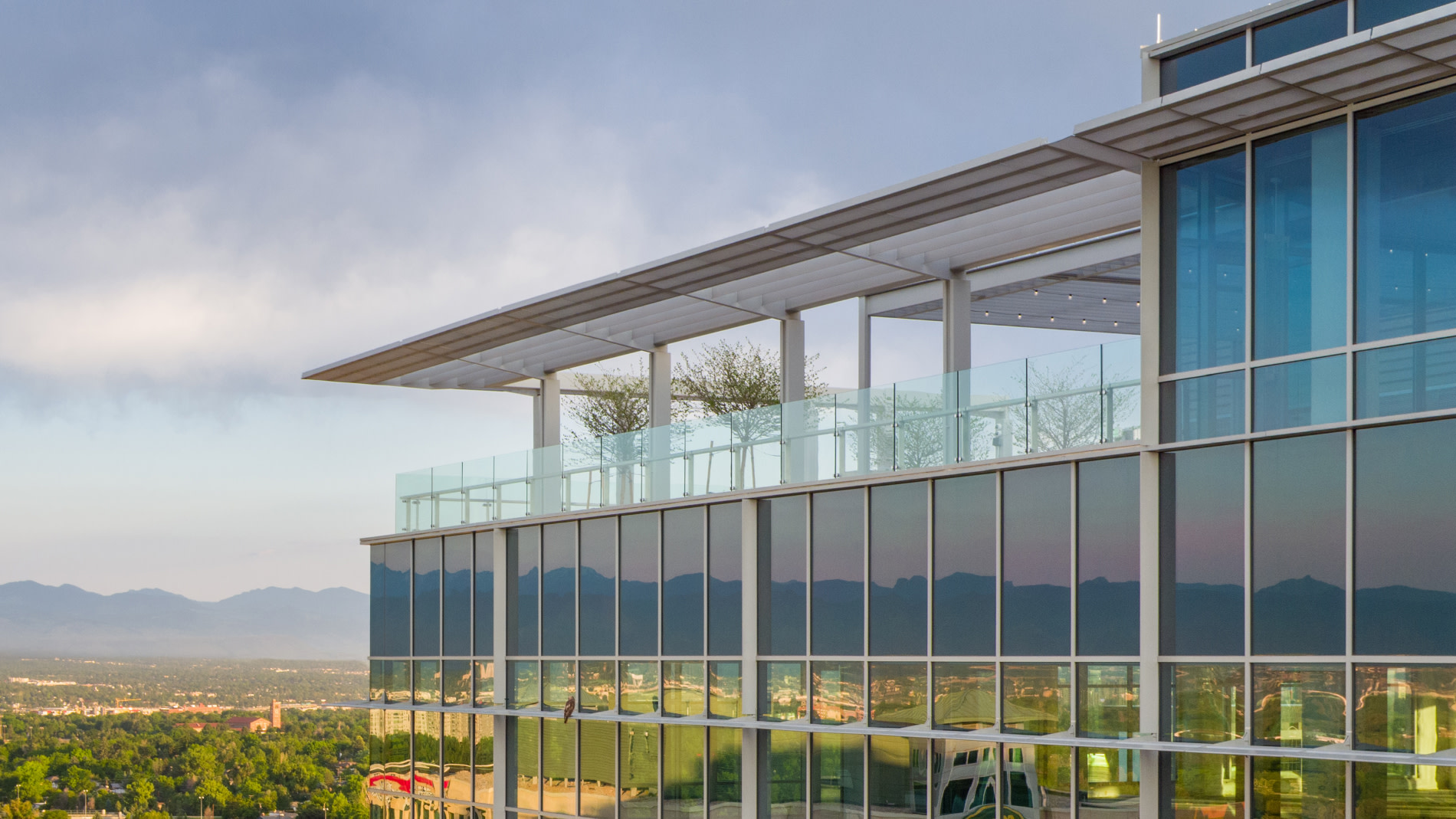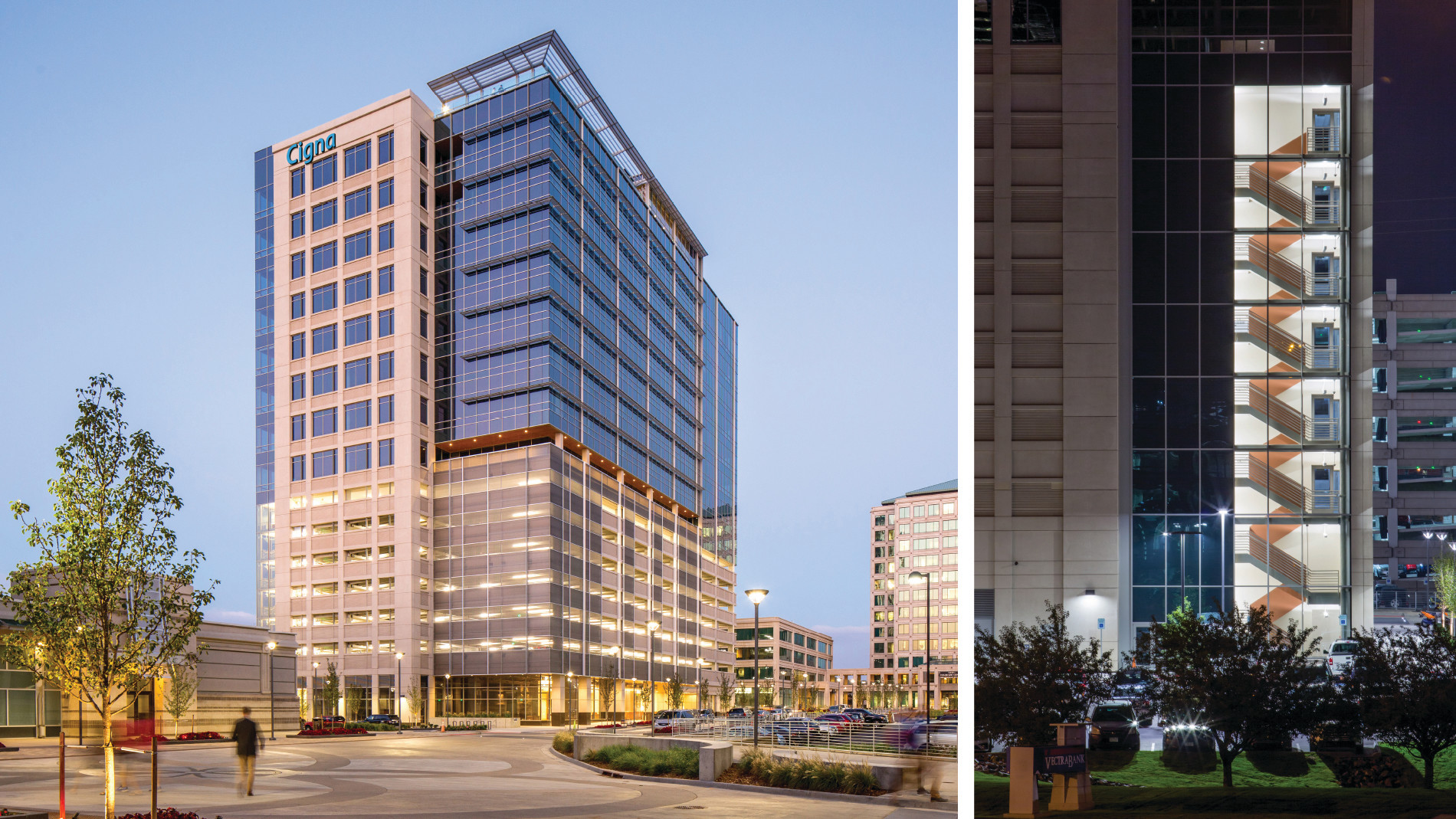
Colorado Center Tower 3 is a sleek new benchmark for architecture in southeast Denver.
Designed by Tryba Architects, the 14-story LEED Silver building includes eight stories of Class AAA office rising above a six-level garage podium with ground-floor retail space.
Tower 3 is the newest addition to Colorado Center, a campus with an entertainment/theater complex anchored by Dave & Buster’s and 720,000 square feet of office space in three towers. Developed by Lincoln Property Company and ASB Real Estate Investments and roughly 300,000 square feet, the building is adjacent to Colorado Station on the RTD light rail system at Interstate 25 and Colorado Boulevard.
Tower 3 doesn’t exist in a vacuum: It’s part of a vision for a campus at Colorado Center that started to emerge more than 30 years ago and was formalized in a 2005 master plan.
Tower 1, designed by Chicago-based Skidmore, Owings & Merrill, set a high bar for the architecture at Colorado Center when it was completed in 1987. “The first building, Tower 1, has withstood the test of time as a solid piece of architecture,” says David Tryba, FAIA, the founder of Tryba Architects. “It’s a classic. Our take was to honor the architecture of Tower 1 in a more contemporary way.”

Tryba likens the potential of Colorado Center to that of Rockefeller Center in New York. “It adds to the city, but is a place unto itself,” he explains. “The buildings work together. That’s what we feel is important in creating place.”
Emmett Harrison, AIA, project manager with Tryba Architects, says that designing a building on a campus like Colorado Center afforded additional opportunities for interplay with outdoor public spaces. “You don’t get that with a standalone building,” he says.
There’s an emerging “Main Street” that will connect the tower and the theater complex on the west side. Expect more development here soon: Lincoln and ASB announced plans to construct a 12,000-square-foot food hall designed by Tryba Architects, with 11 vendor stations for local chef-driven concepts, a live performance venue, and an outdoor plaza by early 2019. Colorado Center will also see more retail, a hotel, and residential development in the near future.
Scott Caldwell, senior vice president of Lincoln in Denver, calls Tower 3 “one of the most desirable work environments in the entire Denver market.”

The tower’s tenants agree. Cigna, the global insurer and health service company, has signed a 135,800-square-foot lease for its regional headquarters in the recently completed tower. Law firm Ogletree, Deakins, Nash, Smoak & Stewart agreed to lease 19,900 square in summer 2017.
Relocating more than 1,000 employees starting in 2019, Cigna will occupy five full floors in Tower 3. John Roble, president of Cigna’s Mountain States Market, calls it “a fantastic 21st-century facility that will provide collaborative workspaces and first-rate amenities.”
The building boasts a number of standout features: high visibility from Interstate 25, a sculptural staircase on the northwest corner, and a distinctive facade with floor-to-ceiling glass and an exposed structure.
Inside, a notably open floor plate maximizes tenant flexibility. “There are a few places it deviates from the typical office mentality,” says Harrison. The lobby is one of them: “It was purposely designed to linger,” with comfortable chairs, a fireplace, art, and free Wi-Fi.

But the most alluring feature might just be up top: The treed 5,300-square-foot all-season terrace on the roof features a NanaWall, catered kitchen, and amazing views. “There is no other space quite like it in Denver,” Harrison says. “It operates as a tenant amenity and an event space that can be rented out. It was designed with multiple uses in mind.”

Tryba Architects’ work at Colorado Center, Union Station, Fox North (the former site of the Denver Post printing plant), Denver Rock Drill, and other emerging nodes on Denver’s transit map is a differentiator for the firm. Another is a longtime focus on urban context: Tryba Architects’ designs react to existing urban fabric and bring something new. A third differentiator is delivering the quality of design that large companies expect.
“All of the transit-oriented sites are about connectivity,” echoes Tryba. “That’s number one. That’s what will begin to define Denver as a world-class city.”
Colorado Center “is another central hub,” says Tryba. It’s not just cars and trains, it’s also buses, bicycles, and pedestrians. “This is the very beginning of a series of nodes up and down the Valley Highway corridor,” he notes. “Downtown is downtown, but Colorado Center will be a launching point for life.”